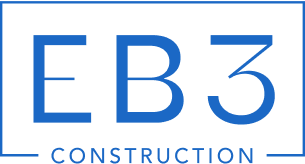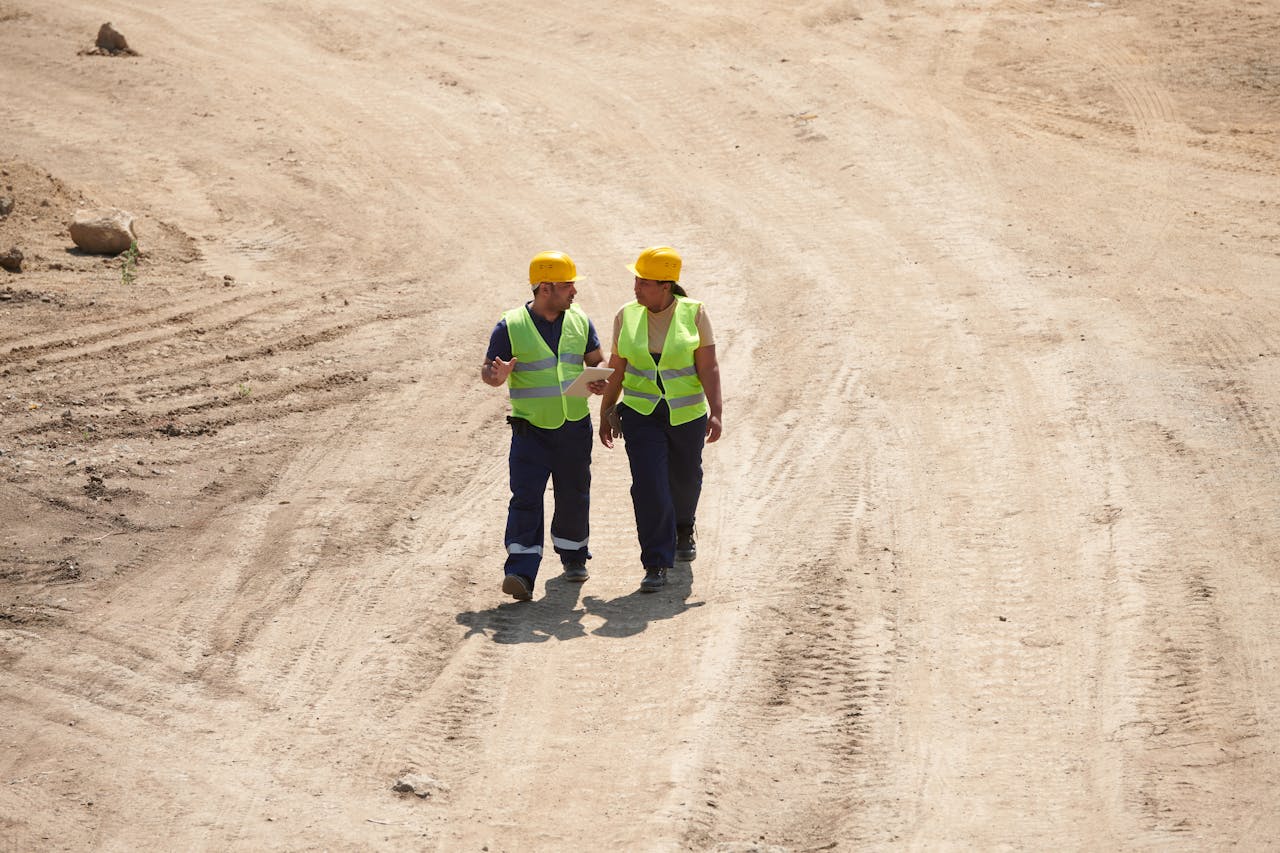Commercial developers face a stark reality: building from an empty lot requires dramatically different expertise than renovating existing space. A ground-up construction general contractor coordinates projects built from undeveloped land to a completed, occupancy-ready building.
The general contractor serves as the project backbone, managing every phase from site preparation through final inspection. We coordinate subcontractors, maintain schedules, enforce safety protocols, and solve on-site challenges that emerge during construction. In commercial projects, this coordination becomes critical as multiple trades, complex systems, and regulatory requirements must align within budget and timeline constraints.
What Phases Make Up A Ground-Up Construction Project?

Ground-up construction follows a structured sequence from initial planning through final occupancy. We manage six core phases that transform your vision into a functioning building. Each phase builds on the previous work while setting up requirements for the next stage.
Pre-Design And Project Initiation
The pre-design phase establishes the project foundation before any detailed planning begins. We define your goals, scope, budget parameters, and timeline expectations during initial meetings. Feasibility studies examine whether your requirements align with site conditions, local regulations, and available resources.
Risk assessment identifies potential challenges early, from soil conditions to zoning restrictions. We also establish preliminary budgets based on your program requirements and comparable project data. This phase typically requires two to four weeks but prevents costly changes later in the process.
Pre-Construction And Design Development
Pre-construction encompasses design development, regulatory reviews, and detailed cost estimation. We coordinate surveys, environmental assessments, and geotechnical investigations to understand site conditions. Zoning reviews confirm that your planned use complies with local regulations and identify any variances needed.
Architectural plans develop from conceptual sketches into detailed construction drawings. We work with your design team to balance functional requirements with budget constraints. Cost estimates become more precise as design details solidify, and we establish realistic schedules based on material availability and labor capacity.
Procurement And Team Assembly
Procurement involves sourcing materials, equipment, and specialized trades for your project. We evaluate subcontractors based on experience, capacity, and pricing to build the right team. Material specifications from the design phase guide sourcing decisions, with delivery schedules coordinated to match construction phases.
Long-lead items like structural steel, custom millwork, or specialized equipment require early ordering to prevent delays. We also secure equipment rentals and temporary facilities needed during construction. Quality contractors often book months in advance, making early procurement critical for maintaining your schedule.
Site Preparation And Infrastructure
Site preparation transforms raw land into a construction-ready work area. We clear vegetation, demolish existing structures if needed, and establish temporary utilities and site access. Grading creates proper elevations and drainage patterns based on civil engineering plans.
Soil testing confirms foundation design assumptions and identifies any remediation needs. Utility connections for water, sewer, electrical, and gas services require coordination with local providers. Site preparation also includes erosion control measures, temporary fencing, and construction staging areas.
Construction And Building Systems
The construction phase progresses from foundation to final finishes following a logical sequence. Foundation work includes excavation, footings, and concrete placement, with careful attention to elevation and alignment. Structural framing follows, whether steel, concrete, or wood construction.
Building enclosure comes next with roofing, exterior walls, and windows to protect interior work from weather. MEP systems (mechanical, electrical, plumbing) rough-in occurs within the framed structure. Interior buildout includes drywall, flooring, millwork, and final fixtures. Exterior work encompasses landscaping, parking, and site improvements.
Inspections And Project Closeout
The closeout phase ensures your building meets all requirements before occupancy. We coordinate inspections with local authorities for structural, electrical, plumbing, mechanical, and fire safety systems. Any deficiencies identified during inspections must be corrected before final approval.
We create and address punch list items – minor corrections and touch-ups identified during final walkthroughs. Documentation delivery includes as-built drawings, warranties, operating manuals, and maintenance schedules. The certificate of occupancy represents official approval for building use and triggers final payment milestones.
How Does The General Contractor Manage Teams, Schedule, Safety, And Quality?
The general contractor serves as the central hub for coordinating all moving parts of a ground-up construction project. We manage multiple specialized trades, align schedules with resource availability, and maintain quality standards while keeping safety at the forefront. This coordination requires constant communication, proactive planning, and the flexibility to adapt when conditions change.
Coordinating Subcontractors And Trade Schedules
We begin by selecting qualified subcontractors through a thorough prequalification process. This involves evaluating past performance, financial stability, safety records, and technical capabilities specific to the project requirements. For instance, healthcare projects demand HVAC subcontractors with proven experience in infection control and air quality systems.
Schedule coordination requires aligning each trade’s timeline with material deliveries and dependencies between different scopes of work. We incorporate schedule float into our planning, where subcontractors receive tighter completion targets than our internal schedule allows. This buffer prevents delays in one trade from cascading to others and provides time for quality corrections if needed.
Daily jobsite huddles and regular progress meetings keep all trades informed of schedule updates, potential conflicts, and coordination requirements. We use these sessions to address concerns before they impact the overall timeline and foster collaboration between different specialty contractors.
Managing Material Logistics And Deliveries
Material coordination involves timing deliveries to match construction phases while accounting for storage limitations and weather protection needs. We work closely with suppliers to establish delivery schedules that align with labor availability and site readiness. This includes coordinating crane access for large components and ensuring adequate staging areas for materials.
Our project managers track material lead times during procurement and build appropriate buffers into the schedule for critical path items. When material shortages or delivery delays occur, we quickly assess alternatives and adjust work sequences to maintain progress in other areas.
Material quality control begins with the submittal process, where we review shop drawings and material samples before ordering. This prevents quality issues and ensures compatibility with project specifications and design intent.
Implementing Safety Protocols And Risk Management
We establish site-specific safety plans that incorporate requirements from all trades working on the project. This includes coordinating safety protocols for overlapping work areas, managing access routes, and ensuring proper fall protection and equipment safety measures. Our superintendent conducts regular safety inspections and addresses hazards immediately.
Risk management extends beyond safety to include weather contingencies, labor availability, and site condition surprises. We maintain contingency funds and alternative work plans to address these challenges without derailing the overall schedule. Insurance requirements and bonding are verified for all subcontractors before work begins.
Communication protocols ensure that safety incidents, quality issues, or schedule concerns are immediately escalated to the project management team for resolution. This prevents small problems from becoming major delays or cost overruns.
Quality Control Through Phased Construction
We break construction into manageable phases that allow for systematic quality control and progress tracking. Each phase includes specific inspection points where work is verified against specifications before proceeding to the next stage. This approach catches deficiencies early when they are easier and less expensive to correct.
Regular inspections involve both our internal team and third-party inspectors as required by code. We document all inspections and maintain detailed records of corrective actions taken. Quality control measures include material testing, workmanship verification, and compliance with building codes and project specifications.
The phased approach also supports budget and schedule control by providing clear milestones for progress payments and resource allocation. This systematic process ensures that each aspect of construction meets standards before subsequent work begins, preventing costly rework later in the project.
What Permits, Financing, And Risks Should Owners Plan For?

Ground-up construction projects require multiple regulatory approvals that span different building systems and phases. We coordinate these approvals early in the pre-construction timeline to prevent costly delays later. The complexity increases with project size and local jurisdiction requirements.
Building Permits Across Multiple Scopes
Structural permits cover foundation work, framing, and load-bearing modifications. These permits typically require engineered drawings and soil reports. Electrical permits address power distribution, lighting systems, and fire alarm installations throughout the building.
Plumbing permits encompass water supply lines, drainage systems, and gas connections. Mechanical permits cover HVAC systems, ventilation requirements, and any specialized equipment installations. Some jurisdictions require separate permits for roofing, signage, and site improvements like parking areas.
We start permit applications during the design development phase, often 60-90 days before construction begins. Most large projects that involve major changes to the structure require permits, and each municipality maintains different approval timelines and documentation requirements.
Construction Financing Structure And Requirements
Lenders evaluate detailed project plans, construction budgets, and realistic timelines before approving funding. They require proof of contractor licensing, insurance coverage, and a comprehensive scope of work. The loan-to-cost ratio typically ranges from 70-80% of total project expenses.
Construction loans operate differently than permanent mortgages. Funds release in scheduled draws tied to completion milestones rather than as a lump sum upfront. We coordinate draw inspections with lenders to verify work progress matches payment requests.
Budget monitoring becomes critical during active construction phases. Lender requirements include regular cost reporting, change order approvals, and documentation of material purchases. Any significant budget deviations require formal approval before additional funds release.
Common Risks That Affect Schedule And Budget
Weather delays impact exterior work phases including foundation, framing, and roofing installation. We build weather contingencies into project schedules, particularly for regions with distinct seasonal patterns. Indoor work can often continue during adverse conditions if the building envelope is complete.
Labor shortages affect specialized trades like electrical, plumbing, and HVAC installation. Skilled workers command premium rates in tight markets, influencing both schedule and budget projections. We maintain relationships with multiple subcontractors to reduce dependency risks.
Material shortages and price volatility create budget pressures throughout construction. Supply chain disruptions can delay critical components like structural steel, windows, and specialized equipment. We track material lead times and secure pricing early when possible.
Unexpected site conditions frequently emerge during excavation and foundation work. Underground utilities, soil contamination, and rock formations can require design modifications and budget adjustments. Pre-construction site investigations help identify these risks but cannot eliminate them entirely.
Insurance Coverage And Risk Management
Comprehensive liability insurance protects against property damage and worker injuries during construction. We verify that all subcontractors carry appropriate workers compensation and general liability coverage. Umbrella policies provide additional protection for high-value projects.
Builder’s risk insurance covers the structure under construction against fire, theft, and weather damage. This coverage typically excludes design errors, faulty workmanship, and normal wear from construction activities. Property owners should understand coverage gaps and consider additional protection.
Contractors must provide proof of licensing and bonding before starting work. Performance bonds guarantee project completion even if the contractor defaults or declares bankruptcy. Payment bonds protect against liens from unpaid subcontractors or suppliers.
Regulatory Approvals And Compliance Planning
Environmental assessments identify potential contamination, wetland restrictions, and habitat protection requirements. These studies influence site design and may require specialized remediation or mitigation measures. Environmental permits often have extended approval timelines.
Zoning reviews confirm that the proposed use aligns with local land use regulations. Variance requests require public hearings and extended approval periods. We coordinate with planning departments early to identify any zoning conflicts or special requirements.
Utility connections require coordination with local service providers for water, sewer, gas, and electrical service. Capacity studies may reveal infrastructure upgrades needed to support the new building. These improvements can significantly impact project budgets and timelines.
Project Closeout And Occupancy Requirements
Final inspections verify that all work meets code requirements and matches approved plans. We coordinate with building officials to schedule comprehensive reviews of all building systems. Failed inspections require corrections before occupancy approval.
Punch list items address minor deficiencies identified during final walkthroughs. We maintain contingency funds specifically for punch list corrections and warranty work. These items must be completed before the certificate of occupancy is issued.
The certificate of occupancy represents official approval for building use and occupancy. This document confirms code compliance, safety system functionality, and accessibility requirements. Most lenders require this certificate before releasing final construction loan proceeds or converting to permanent financing.
Ground-Up Vs. Build-Out: Which Approach Fits Your Goals?
Choosing between ground-up construction and build-out depends on balancing your priorities against practical constraints. Each approach delivers distinct advantages that can significantly impact project success, but neither fits every situation.
Ground-Up Construction Advantages
Ground-up construction offers complete design freedom. We can tailor every aspect of the building to your exact specifications, from foundation systems to roofing materials. This flexibility proves especially valuable for businesses with specialized operational requirements or unique industry-specific needs.
Modern infrastructure integration happens seamlessly in new construction. We install the latest building systems, energy-efficient technologies, and smart building features from the start. These modern systems often deliver better performance and lower long-term operating costs compared to retrofitting older buildings.
Brand alignment becomes achievable when starting from scratch. The building’s architecture, layout, and aesthetic elements can reflect your company’s identity and values. This creates a powerful impression on clients and supports marketing objectives in ways that renovated spaces often cannot match.
Scalability planning allows for future growth without major disruption. We can design structures with expansion phases in mind, accommodating additional square footage or different uses as business needs evolve. This forward-thinking approach supports long-term business strategies.
Operational continuity remains intact during construction. Your existing operations continue uninterrupted while we build the new facility. This eliminates the productivity losses and logistical challenges that often accompany renovation projects in occupied buildings.
Ground-Up Construction Challenges
Higher upfront costs represent the most significant barrier for many property owners. Land acquisition, site preparation, and new construction materials require substantial initial investment. These costs often exceed build-out budgets by 30-50% depending on location and complexity.
Extended timelines can delay occupancy by months or years. Ground-up projects typically require 12-24 months from design to completion, while build-outs often finish within 3-8 months. Permit approval processes alone can consume six months in complex jurisdictions.
Complex approvals involve multiple regulatory bodies and extensive documentation. Zoning approvals, environmental assessments, and building permits each carry potential delays. We navigate these requirements, but the approval process remains beyond anyone’s direct control.
Build-Out Project Advantages
Faster delivery gets businesses operational quickly. Existing buildings already have structural systems, utilities, and basic infrastructure in place. This head start can reduce construction time by 50-70% compared to ground-up alternatives.
Lower initial costs make build-outs accessible for businesses with limited capital. Renovation typically costs less than new construction because existing structural elements, foundations, and major systems remain in place. Property acquisition costs also tend to be lower for existing buildings.
Prime locations become available through existing buildings that may be impossible to replicate with new construction. Established commercial districts, downtown areas, and high-traffic corridors offer built-in customer access that justifies renovation investment.
Material reuse supports sustainability goals by reducing waste and conserving resources. Repurposing existing structures, fixtures, and architectural elements can contribute to LEED certification and other environmental objectives while reducing material costs.
Build-Out Project Challenges
Limited structural changes constrain design possibilities. Load-bearing walls, ceiling heights, and existing utility locations create boundaries that may not align with optimal layouts. These renovation constraints often require design compromises.
Hidden costs emerge when older buildings reveal unexpected issues. Asbestos, lead paint, outdated electrical systems, or structural deficiencies can add thousands to project budgets. These discoveries often surface after construction begins, complicating schedule and cost control.
Code compliance work becomes complex in older buildings. Bringing existing systems up to current standards often triggers additional requirements throughout the structure. Fire suppression, accessibility, and energy efficiency upgrades can expand project scope significantly.
Decision Criteria For Project Selection
Budget analysis should include both initial construction costs and long-term operational expenses. Ground-up projects cost more upfront but may offer better lifecycle value through modern infrastructure and lower maintenance requirements.
Timeline requirements determine feasibility for time-sensitive business launches. Build-outs suit situations where quick occupancy outweighs customization benefits, while ground-up projects work better for long-term planning horizons.
Location priorities influence the available options. If your business requires specific geographic positioning, existing building availability may drive the decision toward build-out regardless of other preferences.
Expansion plans affect space design requirements. Businesses planning significant growth benefit from ground-up construction’s scalability, while stable operations may find build-outs perfectly adequate for current and anticipated needs.
Industry-specific requirements often favor one approach over another. Manufacturing, healthcare, and laboratory facilities typically need ground-up construction for specialized systems, while retail and office uses adapt well to existing buildings.
A ground-up construction general contractor such as EB3 Construction can evaluate these factors against your specific situation and help determine which approach aligns best with your business objectives and constraints.
Conclusion And Next Steps

Ground-up construction projects require comprehensive planning and precise coordination across multiple phases and teams. A ground-up construction general contractor serves as the central coordinator, guiding every aspect from pre-construction planning through procurement, site preparation, construction execution, and final closeout to maintain budget and schedule targets.
The process involves significant complexity, with architects designing the vision, engineers ensuring structural integrity, and various trades executing specialized work under tight timelines. Schedule phasing becomes critical to sequence activities properly, manage resource allocation, and coordinate final inspections and punch list completion before occupancy.
Ready to move forward with your ground-up project? Define your goals and scope clearly, confirm project feasibility and establish a realistic budget, assemble your core team including a general contractor, architect, and engineers, initiate permit applications and secure financing early in the process, develop a phased construction schedule, and plan for systematic inspections and punch list management.
For coordination and objective guidance throughout your ground-up construction project, contact EB3 Construction.




